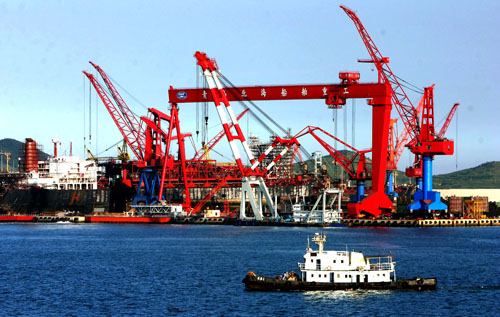Fluorinated coating is utterly repellentby Mark Peplow, special to C&EN
一種透明的、有自愈能力的薄涂層能夠抵抗包括濃酸與低表面張力溶劑在內(nèi)的一百多種液體的侵蝕

The new fluorinated coating protects a polystyrene petri dish from a droplet of the solvent tetrahydrofuran (colored blue)。 The solvent normally dissolves this plastic.
Credit: Nat. Mater.
有些防水涂層浸泡在水里時(shí)仍能夠保持干燥,也有些涂層可以隔絕油以及有機(jī)溶劑。還有一些涂層則可以耐受?chē)?yán)酷的環(huán)境,可應(yīng)對(duì)強(qiáng)酸及高溫,甚至在被破壞后能夠自愈。
如今,研究人員創(chuàng)造了防護(hù)涂層領(lǐng)域名副其實(shí)的瑞士軍刀。由于其獨(dú)特的化學(xué)性能和質(zhì)地,這種涂層在結(jié)合了以上提到的所有性質(zhì)之外,還具有其他的性能(Nat.Mater。2018,DOI:10.1038/ s41563-018-0178-2)。“我們控制一系列不同的結(jié)構(gòu),從化學(xué)鍵到微觀水平的納米結(jié)構(gòu)。”墨爾本大學(xué)的弗蘭克卡魯索(Frank Caruso)說(shuō)道。他是這個(gè)超級(jí)全能材料研發(fā)團(tuán)隊(duì)的研究人員之一。
上面提到的涂層是一種包含了1H,1H,2H,2H-全氟己基三氯硅烷(PFTS)和氰基丙烯酸正丁酯(n-BCA)的混合物,在二氯五氟丙烷溶液中混合。當(dāng)其被噴涂于表面時(shí),空氣中的水蒸氣會(huì)引發(fā)PFTS和n-BCA之間的一系列聚合反應(yīng),形成堅(jiān)韌、透明的薄膜。該薄膜涂層含有聚合物納米粒子,會(huì)聚合并形成具有良好質(zhì)地的涂層面,而這些涂層面可以捕獲微小的空氣形成的氣泡隔層,以起到阻攔液體的作用。
在測(cè)試中,該涂層可以阻隔包括水、正戊烷、全氟己烷和濃氫氟酸在內(nèi)的100多種不同的液體。液滴通常在涂層上形成似球形的水珠,并與圖層面形成至少150度的接觸角。擁有這種接觸角數(shù)值的涂層通常會(huì)被認(rèn)為具有“超防液性”。略微傾斜表面– 通常小于5度– 便足夠使液滴干脆利落地從涂層表面滾離。當(dāng)正戊烷(一種具有非常低的表面張力并且會(huì)弄濕大多數(shù)表面的化合物)被噴到該涂層上面時(shí),涂層表面能夠輕易地將其彈落。

A jet of pentane bounces right off this stainless steel mesh, thanks to its super-repellent coating. This solvent will wet most surfaces.
Credit: Nat. Mater.
研究人員表示,n-BCA可作為一種強(qiáng)力粘合劑,將上述涂料固定在包括木材、金屬、玻璃和滌綸織物在內(nèi)的各種材料上。卡魯索認(rèn)為,這種強(qiáng)粘合力還可以降低涂層逃逸到環(huán)境中的風(fēng)險(xiǎn),而這一問(wèn)題一直困擾著其他多氟化合物的應(yīng)用。

該涂層在100℃也能繼續(xù)排斥液體,并在刮擦、研磨和洗滌后保持其性能。只有當(dāng)研究人員用氧等離子體沖刷它時(shí),該涂層才會(huì)失去其防液性。即便如此,該材料也能在受到上述處理后,在室溫下24小時(shí)后自愈,或者在120°C時(shí)于10分鐘內(nèi)恢復(fù)。也就是說(shuō),當(dāng)該涂層中的聚合物鏈重組時(shí),該涂層會(huì)重獲其先前所有的超能力。

The microscopic structure of the new fluorinated coating may help to create a cushion of air that improves its repellent properties.
Credit: Nat. Mater.
來(lái)自馬克斯×普朗克聚合物研究所、研究超級(jí)防液涂層的Doris Vollmer表示,許多上述提到的超級(jí)防液性能已經(jīng)被融入到了以前發(fā)明出來(lái)的材料中。但是這次的涂層對(duì)正戊烷的排斥能力是不尋常的,因?yàn)樵撏繉幽茉谧晕倚迯?fù)后完全恢復(fù)對(duì)正戊烷液體的抵抗性。“這比我見(jiàn)過(guò)的其他涂料更好。”她說(shuō)。
杜勒姆大學(xué)開(kāi)發(fā)功能表面材料的Jas Pal S. Badyal說(shuō),這種涂料簡(jiǎn)單的噴涂方法,也能使其在商業(yè)應(yīng)用上更具吸引力。“這種一步到位的(噴涂)方法很好。”他說(shuō)。然而,使用二氯五氟丙烷作為涂料前體的溶劑,可能成為商業(yè)推廣中的絆腳石,因?yàn)檫@些鹵化物對(duì)環(huán)境有負(fù)面影響。

A drop of pentane falls onto a piece of fabric with a super-repellent coating.
Credit: Nat. Mater.
Caruso建議,這種材料最終可以開(kāi)發(fā)成用于屏蔽化學(xué)危害的涂層,并且該團(tuán)隊(duì)已經(jīng)開(kāi)始與工業(yè)伙伴合作。“但這種材料在應(yīng)用方面仍有很長(zhǎng)的路要走。”他補(bǔ)充說(shuō),并指出研究人員需要降低涂層成本并評(píng)估其長(zhǎng)期耐用度。
Transparent, self-healing film fends off more than 100 liquids, including concentrated acids and low-surface-tension solventsSome liquid-repelling coatings stay dry in a deluge of water, while others rebuff oils and organic solvents. Some can withstand harsh treatment, shrugging off harsh acids, high temperatures, or even healing themselves after being damaged.
Now researchers have created a veritable Swiss Army knife of a repellent coating that combines all of these properties and more, thanks to its unique chemistry and texture (Nat. Mater. 2018, DOI: 10.1038/s41563-018-0178-2)。 “We're controlling a range of different structures, from the chemical bond to the nanoscale to the microscopic level,” says Frank Caruso of the University of Melbourne, part of the team behind the super-omniphobic material.
The coating is a mixture of 1H,1H,2H,2H-perfluorohexyltrichlorosilane (PFTS) and n-butyl cyanoacrylate (n-BCA), combined in a dichloropentafluoropropane solution. When sprayed onto a surface, water vapor in the atmosphere triggers a series of polymerization reactions between PFTS and n-BCA to create a tough, transparent film. The coating contains polymer nanoparticles that aggregate to form a highly textured surface, which may trap tiny pockets of air to help ward off liquids.
In tests, the coating repelled more than 100 different liquids, including water, n-pentane, perfluorohexane, and concentrated hydrofluoric acid. Droplets of liquid typically formed almost spherical globules on the coating, with contact angles of at least 150 degrees—generally regarded as the mark of a super-repellent surface. Slightly tilting a surface—typically less than 5 degrees—was enough to make the droplets roll off cleanly. A jet of n-pentane, which has a very low surface tension and will wet most surfaces, simply bounced off coated surfaces.
The reserchers say that n-BCA acts as a powerful adhesive to anchor the coating to a wide range of substances, including wood, metal, glass and polyester fabric. Caruso suggests that this strong adhesion may also reduce the risk of the coating escaping into the environment, a problem that has bedeviled other polyfluorinated compounds. The coating continued to repel liquids at 100 °C and retained its properties after scratching, abrading, and washing. Only when the researchers scoured it with oxygen plasma did it lose its repellency. Even then, the material healed itself after 24 hours at room temperature, or in just 10 minutes if heated to 120 °C, regaining its full complement of super powers as its polymer chains reorganized themselves.
Many of these properties have been combined in previous materials, says Doris Vollmer at the Max Planck Institute for Polymer Research, who studies super-repellent coatings. But the coating's ability to repel n-pentane is unusual, as is the complete recovery of n-pentane repellency after self-healing. “That is better than I've seen with other coatings,” she says.
The simple, spray-on method could also make this coating attractive for commercial applications, says Jas Pal S. Badyal, who develops functional surfaces at Durham University. “The one-step approach is good,” he says. However, using dichloropentafluoropropane as a solvent for the coating's precursors could be a stumbling block, he adds, due to the environmental impact of such halogenated compounds.
Caruso suggests that the material could eventually be developed into a coating for chemical hazard shielding, and the team is already working with industry partners. “But there's still a long way to go in terms of applications,” he adds, noting that they need to reduce the cost of the coating and assess its long-term durability.
This article is reproduced with permission from Chemical & Engineering News (? American Chemical Society)。 The article was first published on OCTOBER 16, 2018 | APPEARED IN VOLUME 96, ISSUE 42.
免責(zé)聲明:本網(wǎng)站所轉(zhuǎn)載的文字、圖片與視頻資料版權(quán)歸原創(chuàng)作者所有,如果涉及侵權(quán),請(qǐng)第一時(shí)間聯(lián)系本網(wǎng)刪除。

官方微信
《中國(guó)腐蝕與防護(hù)網(wǎng)電子期刊》征訂啟事
- 投稿聯(lián)系:編輯部
- 電話:010-62313558-806
- 郵箱:fsfhzy666@163.com
- 中國(guó)腐蝕與防護(hù)網(wǎng)官方QQ群:140808414





